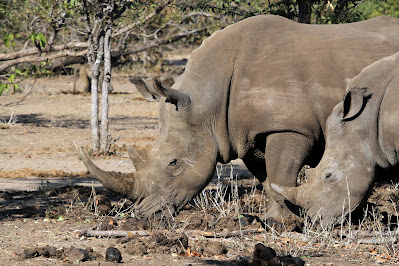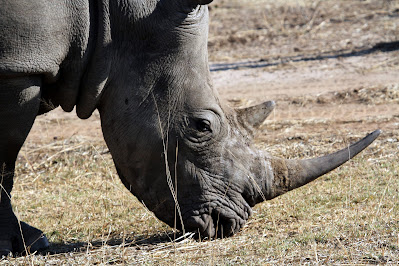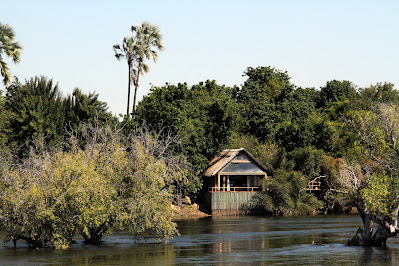 |
| Cindy & Mary with two rhinos |
We walked out to the common area for breakfast and enjoyed the winter sunrise. The breakfast choice for Mark, Cindy and I was omelettes of varying types. Mary had maize porridge. We gathered our things for the walk into Mosi-Oa-Tunya National Park to see the rhinos. The rhino walk was a part of our African trip that we are really looking forward to.
 |
| Mother and daughter rhinos |
The National Park was about a 30 minute drive from the camp. Once in the park we saw the site where missionaries in the early 1900s attempted to establish the town of Livingstone. However, everyone in the group died of malaria. Their graves remain in the park. After the failure of the site, the town was established at the present site of Livingstone in the 1920s.
 |
| Ernest, a National Park ranger |
There are nine white rhinos in the park as well as a population of elephants, hippos, Cape buffalo, zebras, warthogs and impala. We were led by Ernest, a National Park ranger who was armed with an AK 47 mostly to defend against elephants. There are no big cats in the park since the road going near the park transports a lot of local people walking or cycling.
The first rhinos that came upon were a mother daughter pair. The young rhino was about two years old and would soon be weaned from her mother. They were lying in the sun when we arrived, so we approached them downwind and were able to get very close. We continued walking through the park and saw five rhinos including one juvenile and one large male. We were also able get closer by walking quietly toward them from downwind.
 |
| Adult rhinoceros |
The rhinos and other animals in the National Park are protected by a staff of well trained and heavily armed rangers. The nine rhinos in the park have not had incidents of poaching, but on several occasions elephants that were wounded by poachers in nearby Zimbabwe arrive in the park. Those wounded elephants are very dangerous and have been known to attack people in the park. All of the rhinos at Mosi-Oa-Tunya National Park are white rhinos, so named because of a mispronunciation of “wide rhinos” because their mouths are wide and blunt, well adapted for eating grasses and sedges in the savanna. Black rhinos have a more pointed snout and browse on trees and shrubs in other parts of Africa. The terms “black” and “white” have nothing to do with the color of the animal. White rhinos are listed as near threatened while black rhinos are considered critically endangered.
 |
| Mary, Cindy, Steve & Mark with rhino herd |
Phixon and Ernest told us that rhinos have poor vision and that we should walk single file about a meter apart so the rhinos would see us as a single large animal that is not familiar to them and, therefore, not a threat. By walking downwind, they would be less likely to be alarmed by our scent. After taking a lot of photos, we got back to the Land Cruiser with Phixon and drove to the city of Livingstone.
 |
| Livingstone markets |
Livingstone is a bustling city with a population of 134,000 and many well preserved buildings from the 1920s. Phixon drove us through the market district where each area is designated by what is being sold in the booth. Sweet potatoes are sold in one area followed by nuts then fruits. The market continued to areas for clothing, electronics, appliances and just about anything that the residents of Livingstone might need. Phixon said that his wife likes to shop at the market so she can negotiate for items unlike at the modern stores. Phixon drove us around Livingstone and showed us some of the city’s landmarks mostly going back to Zambia’s colonial past in the 1920s.
We stopped at the Livingstone Museum where we spent about an hour looking at Zambia’s history going back to prehistoric time. The museum has displays on the prehistory of the area including fossil finds of hominids that have guided archeologists in studying the development of humans. A large diorama shows daily life for a Zambian family before the arrival of Europeans. There are a number of artifacts surrounding Dr. David Livingstone and his missions to Central Africa.
After leaving the museum, we returned to the boat launch. The boat brought us to camp where we changed clothes for lunch. We had only a few minutes at camp until we were taken to another island for an outdoor lunch. Chef Paul’s team had prepared roast chicken in a curry sauce with pumpkin and garden salad. Dessert was a mixed fruit plate. The staff was dressed in traditional Zambian colors as they prepared and served the meal. We enjoyed the lunch before boating back to the camp to have a break. On the boat trip back to Sindabezi Island, we saw a large hippopotamus on the bank ready to jump into the Zambezi River.
After a brief break back at the camp, we met Phixon at 4:30 for a boat ride and fishing. We went up river then cast Mepps spinners along the reeds hoping to catch a tiger fish. We saw several local fishermen in mokoros using cast nets in the reed beds. Luck wasn’t with us and neither Mark, Phixon nor I had a bite.
We returned to camp at 6:30 and had about an hour until we met at the campfire with appetizers before dinner. The starter was lentil soup with ginger. We were escorted to our tables where we had excellent filet minion cooked medium rare. Mashed potatoes and streamed vegetables were on the side. Dessert was a stewed pear in caramel sauce.
As we were preparing to leave the table, Chef Paul, Chiyeso, Memory, Jacob, Phixon, Gift, Sylvester, Precious and other camp staff came out to sing and dance to celebrate Mark and Cindy’s 44th anniversary. They brought a chocolate cake along to celebrate. We gave half of the cake to two French visitors at a nearby table.
As we were finishing dinner, Mark had an alert that his credit card may have been used for fraudulent purchases and transfers. They were making telephone calls to financial institutions to straighten out the mess.
We went to the tent, made our calls and updated the journal before turning in. We have a 10:20 am departure time for Potato Bush Camp tomorrow. We enjoyed this camp just as much as the other three that we visited this month, although the pace was much more relaxed than at Xakanaxa and Savute.
 |
We stopped at the Livingstone Museum where we spent about an hour looking at Zambia’s history going back to prehistoric time. The museum has displays on the prehistory of the area including fossil finds of hominids that have guided archeologists in studying the development of humans. A large diorama shows daily life for a Zambian family before the arrival of Europeans. There are a number of artifacts surrounding Dr. David Livingstone and his missions to Central Africa.
 |
| Lunch along the Zambezi River |
After leaving the museum, we returned to the boat launch. The boat brought us to camp where we changed clothes for lunch. We had only a few minutes at camp until we were taken to another island for an outdoor lunch. Chef Paul’s team had prepared roast chicken in a curry sauce with pumpkin and garden salad. Dessert was a mixed fruit plate. The staff was dressed in traditional Zambian colors as they prepared and served the meal. We enjoyed the lunch before boating back to the camp to have a break. On the boat trip back to Sindabezi Island, we saw a large hippopotamus on the bank ready to jump into the Zambezi River.
 |
| Mark & Cindy's tent at Sindabezi Island Camp |
After a brief break back at the camp, we met Phixon at 4:30 for a boat ride and fishing. We went up river then cast Mepps spinners along the reeds hoping to catch a tiger fish. We saw several local fishermen in mokoros using cast nets in the reed beds. Luck wasn’t with us and neither Mark, Phixon nor I had a bite.
We returned to camp at 6:30 and had about an hour until we met at the campfire with appetizers before dinner. The starter was lentil soup with ginger. We were escorted to our tables where we had excellent filet minion cooked medium rare. Mashed potatoes and streamed vegetables were on the side. Dessert was a stewed pear in caramel sauce.
 |
| Sunset on the Zambezi River between Zambia and Zimbabwe |
As we were preparing to leave the table, Chef Paul, Chiyeso, Memory, Jacob, Phixon, Gift, Sylvester, Precious and other camp staff came out to sing and dance to celebrate Mark and Cindy’s 44th anniversary. They brought a chocolate cake along to celebrate. We gave half of the cake to two French visitors at a nearby table.
As we were finishing dinner, Mark had an alert that his credit card may have been used for fraudulent purchases and transfers. They were making telephone calls to financial institutions to straighten out the mess.
We went to the tent, made our calls and updated the journal before turning in. We have a 10:20 am departure time for Potato Bush Camp tomorrow. We enjoyed this camp just as much as the other three that we visited this month, although the pace was much more relaxed than at Xakanaxa and Savute.
No comments:
Post a Comment